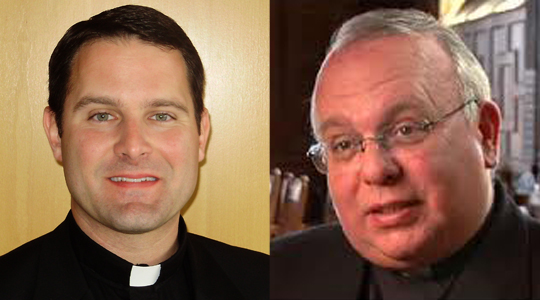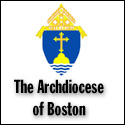Listen to the show:
Podcast: Play in new window | Download
Today’s host(s): Scot Landry
Today’s guest(s): Fr. Jonathan Gaspar, Priest-Secretary to Cardinal Seán O’Malley and Director of the Archdiocesan Office for Worship, and Msgr. Andrew Wadsworth, Executive Director of the International Commission on English in the Liturgy (ICEL)
- International Commission on English in the Liturgy
- The US Conference of Catholic Bishops’ site on the new Roman Missal
- The Archdiocese of Boston site on the new Roman Missal
Today’s topics: The new translation of the Roman Missal
Summary of today’s show: On the First Sunday of Advent at the end of November, the Church in the United States will mark a historic moment where the texts of the Mass we celebrate each day will change. Why are they changing? What are they changing to? How will it affect how we sing at Mass? Is it taking us back to the Middle Ages? All these questions and more will be answered as Scot Landry is joined by Fr. Jonathan Gaspar of the Archdiocese’s Office of Worship and Msgr. Andrew Wadsworth of the International Committee on English in the Liturgy, which was largely responsible for this new translation of the Roman Missal.
1st segment: Scot said the first Sunday of Advent this year marks a momentous occasion in the history of the Church, because we will begin praying the liturgy in new ways that will help us deep the sense of reverence and the sacred. One of the worldwide experts on these changes is with us.
The ICEL has a major task to help creation translations that are faithful to the original Latin texts of the Church’s liturgical texts. Msgr. Wadsworth said ICEL is a commission of 11 bishops who represent the territories of the world where the Mass is celebrated in English: the US, Canada, Ireland, England & Wales, Scotland, Australia, New Zealand, the Philippines, India, Pakistan, and South Africa. ICEL is responsible for all of the liturgical texts, including those for the Mass. It started its work even during the Second Vatican Council, translating texts at the time. It’s a collaboration of 11 bishops’ conferences, which have responsible for the liturgical texts in their countries, and ICEL provides assistance to them.
ICEL was originally funded by an initial contribution from the 11 conferences, and since that time it collects copyrights on the liturgical texts from the publishing of the books containing the works. It enables them to subsidize the production of liturgical books in poorer areas. Msgr. said the staff of the permanent secretariat which is located in Washington, DC, is 5 people, with collaborators all over the world.
Msgr. said when there’s a text to be translated from Latin, they have a base translation by a person authorized by the Church to undertake the work. They have linguistic ability as well as a theological background. Their first draft goes to a committee of four bishops who have those same gifts and they assess the translation line by line and word by word. From them, the text goes to the 11 bishops of the ICEL board, who meet at least once per year. At that point the text, which is called the Green Book, goes to the individual bishops conferences and all of those bishops study and reflect on the text and consult anybody they want to help them. All of that comes back to the ICEL offices and they apply them to the text.
On the large-scale, the Church has given general guidelines, which were mostly issued in 2001. And then more specific guidelines have been issued in the Ratio Translationis for the English language, which are the specific considerations which have to be born in mind when translating into English. What the bishops are often able to identify are those things which might be insensitive in relation to their own territory. English is a worldwide language, but it’s used differently in different places.
Scot asked how they balance the concerns between countries and bishops. Msgr. said they balance the universal with the local. The liturgy belongs to everyone and there is a single English text for everyone to have. Because the character of the text is more formal than the English we use today, that’s the level in which English is used throughout the world. Ultimately, the text is established by a process of voting. There has to be a greater than two-thirds majority of the bishops for a text to be established.
After all the amendments and suggestions have been applied, it is called the Grey Book. The bishops then vote on it. That establishes the text, which goes back to the Congregation for Divine Worship in Rome who needs to authorize the text for publication and implementation. The text is voted up or down in its entirety. The Congregation, assisted by the Vox Clara committee which helps the Congregation with anything in English, can amend the text as they see fit at any stage of the process because they have overall authority over liturgy in the Church.
The first version of the current Latin missal came after the Vatican Council in 1969 and the English was published in 1973. In 2001, new guidelines for translation were issued and the updated version of the Latin missal in 2002. So it’s taken about 10 years to implement the translation of the new Roman Missal in English.
Scot asked how many languages the Latin is translated into. Monsignor thought it was in the hundreds of languages. In addition to the 11 members of ICEL, there are more than 20 that use the English liturgies even though English isn’t the main spoken language of the place.
Monsignor said it’s the work of many hands. The Liturgy is the center of our life as a Church and so great care must be taken in every step of the process.
2nd segment: Monsignor said when the current translation was implemented in 1973 and it was thought there would be a revision done pretty quickly, within 5 or 10 years, but it’s taken 40 years. Scot asked why they thought a revision would be needed.It was because it was our first experience of vernacular liturgy instead of Latin. We’re still very young in our experience of that.
In the 1980s, ICEL surveyed people on what they expected from a revision. First, they thought the present translation doesn’t convey all of the content of meaning of the original Latin text. Second, there is an absence of the special vocabulary we use in speaking about our faith that convey so many important concepts. Third, it was thought the language we use in everyday language was not suited to use in liturgy. Monsignor himself has experienced this moving from the United Kingdom to the United States. The difference is language is diminished by using more formal language, such as we would use in poetry or literature. This is a style of language we share across the world.
Fr. Jonathan said he compares it to the new renovated apse at St. John’s Seminary. Father said he had been at the seminary for eight years and they had a beautiful painting over the apse of the chapel that depicts the Pentecost scene. Just this past summer, that painting was restored and removed years of smoke damage from candles and incense. Now when you look at it, you see not only St. Peter, but also the keys in his hands. By analogy that’s what the new translation is giving us. The old translation gives us the big picture, we see Peter. But in the new translation we see Peter in 3D. All of the imagery the Church gives us is restored in this text.
Scot asked if the absence of vocabulary was because of the quickness or the desire to make it as colloquial as possible. Monsignor said it was a little of both. The old translation was completed in just about 2 short years from beginning to end. The guidelines issued by the Congregation for Divine Worship at the time favored a more conversational style of English. There has been a change in the translation approach. The cumulative effect is that ideas that are very important in the liturgy are lessened, so now we are expanding some of those concepts in the new translation.
Scot asked about the new words that may be unfamiliar to some Catholics. Monsignor said we have a lifetime to plumb the riches of the liturgy and catechesis can help us to deepen our appreciation for these mysteries.
Scot asked why the new translation will be more beautiful? Monsignor said one of the characteristics of the original Latin texts is that they’re beautiful themselves. Many of them date back nearly two millennia. The new guidelines instruct that when translating, the beauty of the form and structure of the original texts must be respected.
Fr. Jonathan commented on the new translation of the Gloria: “We praise you, we bless you, we adore you, we glorify you, we give you thanks for your great glory.” Some might say that’s just a wordier way of saying what we’ve been saying along: “We worship you, we give you thanks, we praise you for your glory.” Monsignor said in the old version all the repetition that is found in the Latin text is suppressed. Repetition is a device in poetry that brings greater emphasis and as you say it, the rhythm of the text is evident. There is music within words and one of the great aspects that has guided this process has been to make that music more evident. Often the bishops of the committee asked to sing the prayer to consider it. These are living, breathing texts for living celebrations of the liturgy.
Scot asked why it’s central that the liturgy not only be spoken, but that we bring back more sacred singing in the Mass? Monsignor said the liturgy is something we do together, it’s not a private prayer. It’s a form of worship that envelops the whole of the church and singing is a way we united our voices and we give a heightened expression to the something that is really important. The beauty of the chant is to call to mind the contemplative, where the whole intention is to draw us in more deeply to the reality of that moment of the Mass and music is a more powerful way to do that. Music unites truth and beauty.
Scot said the first time he’s seen a priest sing the Mass it was beautiful, even though he just had a good voice. Fr. Jonathan said it’s not just for musicians. To hear someone who doesn’t have a trained voice do so is beautiful. St. Augustine said, “Only the love sings.” When we sing, we put our praise of God into song, not because we have good voices, but what we’re called to express in our worship, which is the praise and love of our Father through the liturgy.
3rd segment: Scot said there’s been a lot of focus on the different responses that the congregation will be saying. Monsignor said the greatest amount of change is in the prayers said by the priest. All of the prayers that change each day and the prayers of the Eucharistic Prayer have changed, but we will be drawn into those prayers as we hear them over and over.
Monsignor said there are 10 Eucharistic Prayers in the Roman Missal, the four main ones and then six for particular needs and reconciliation. they’ve all been set to music in both a simple and solemn tone. This version of the missal will have more music than any previous version. This is music that is not the hymns, but all the chants for the order of the Mass. It is all Gregorian chant. This doesn’t supplant all other forms of music, but it belongs to the whole Church and is a form of music we will share with all parts of the world that worship in English.
Special chants for particular times of the year are included, including Holy Week, Palm Sunday, the Triduum.
Scot said the words of the Gloria are changing. Does that mean all of the sung Glorias that people sing now will go away? Monsignor said each national conference of bishops has issued guidelines to help composers through this transition. In the case of settings of the Mass that are already familiar, they have mostly been revised to bring them into conformity. A certain bit of flexibility is allowed, but there is a move away from paraphrase.
Fr. Jonathan said he has many hopes with regard to how the new translation affects the music of the Mass. It’s the first time we’ve received one musical setting of the Mass that he hopes will become common. On a local level, in the 289 parishes of the Archdiocese, there are many beautiful settings of the Mass are sung and many he would never be able to sing with because he hasn’t heard them before. One setting means it’s one we can all know and sing and pray together. It doesn’t exclude other settings from publishers, but the chant in this missal is very beautiful. He’s had reports from music directors who had been skeptical that to their surprise the people are responding to the chants and that even the children are singing them and loving them.
Scot asked why Gregorian chant is recommended so strongly versus more contemporary music. Monsignor said the chant has three qualities that make it special: First, it’s universal that belongs to everyone in the Church and doesn’t have a direct secular equivalent. Second, it is thus very spiritual music. It doesn’t bear the mark of changing styles in music, it’s timeless. Often people find it attractive because it can’t be placed in any particular time period. Third, it bear repetition. If we sing it every day, it doesn’t get stale. Many of the current styles are appropriate for instrumental accompaniment and large groups of singers, whereas they are not appropriate for weekdays and smaller congregations.
Fr. Jonathan said a lot of musicians ask if they can use an organ with the chants, he says it’s okay to help them in the beginning, but ideally Gregorian chant puts the emphasis on the word that is being sung. The musicians also say they don’t know how to sing chant, but he points to the example of the children’s choirs. If you put a line in front of them, even in Latin, the children pick it up very easily. You don’t need special training in chant. He’s hoping to offer workshops on chant in the upcoming year.
4th segment: Scot mentioned some criticisms of the new translation. Some say it brings us back to the Middle Ages. Monsignor said this is just not true. The texts of the Mass go back to first millennium, but the current translation is well-translated and faithful.
What about some of the new words feeling clunkier, like consubstantial in the creed. Fr. Jonathan said there’s a whole theological language we’re going to notice and it’s very precise, especially with regard to the relationships within the Trinity. It’s going to require catechesis and is a wonderful opportunity for priests and deacons to preach on Sundays about our liturgical texts, which is one of our main sources of our preaching in the Mass. It begins the first Sunday of Advent but is a work of catechesis that continues in years to come.
Some people say it will be hard to implement on the parish level. Monsignor said the Church is very resourceful with many men and women of great gifts that will be brought into play. We’re continually invited to greater and more active participation in the liturgy and this is the opportunity to assess our experience of the liturgy and dare to do things differently.
What about the claim we’ll be praying more Latin? Fr. Jonathan said we’ve always had the option to pray in Latin, which is the official language of the Church. This new translation from Latin into English. It does not require more Latin being sung, but it wouldn’t be a bad thing to hear the original Latin melodic line to give people a sense of the long history we have as Catholics.
What about the fact that two-thirds of people on Christmas for whom this will be new? Monsignor said the experience of the liturgy once it’s implemented will carry people along. It’s important to address the Christmas phenomenon. It’s important for them to know that the Church they belong to is a living reality that is changing and growing. The Church will be extending an invitation to everyone who comes to Christmas to be more actively and consciously engaged in the life of the Church. For some people who aren’t involved in the Church may be unsettled at first, but it might sharpen the invitation for them to rejoin us on a regular basis.
Fr. Jonathan said the biggest misconception was that this text somehow came to us from a committee of one or two in the Vatican. Monsignor effectively rebutted that claim. So many faithful people, including the bishops and the thousands who assisted them, produced a text that really reflects the work of many hands.
Monsignor encouraged everyone to joyfully receive this gift from the Church. Apart from expressing all the truths of the faith we believe, it’s the most powerful way we receive grace from God to become holy. We sing in the middle of the Mass, “holy, holy, holy,” and the purpose of the Mass is to help us become what we sing.








Comments Closed
Trackbacks/Pingbacks
[…] shownotes for this episode may be found at original airdate’s show page. chant, Fr. Jonathan Gaspar, Gregorian, ICEL, Landry, Latin, liturgy, mass, Msgr. Andrew […]